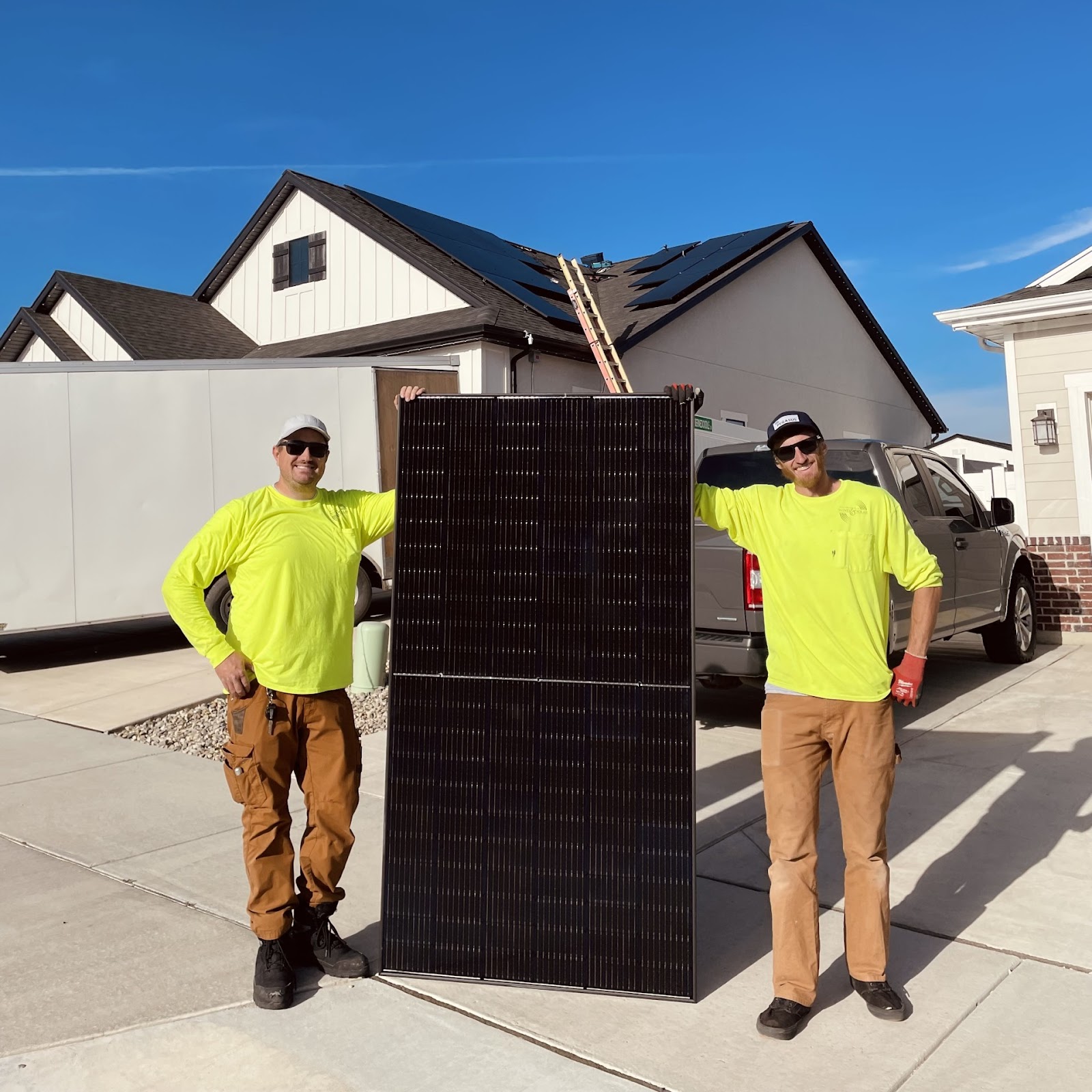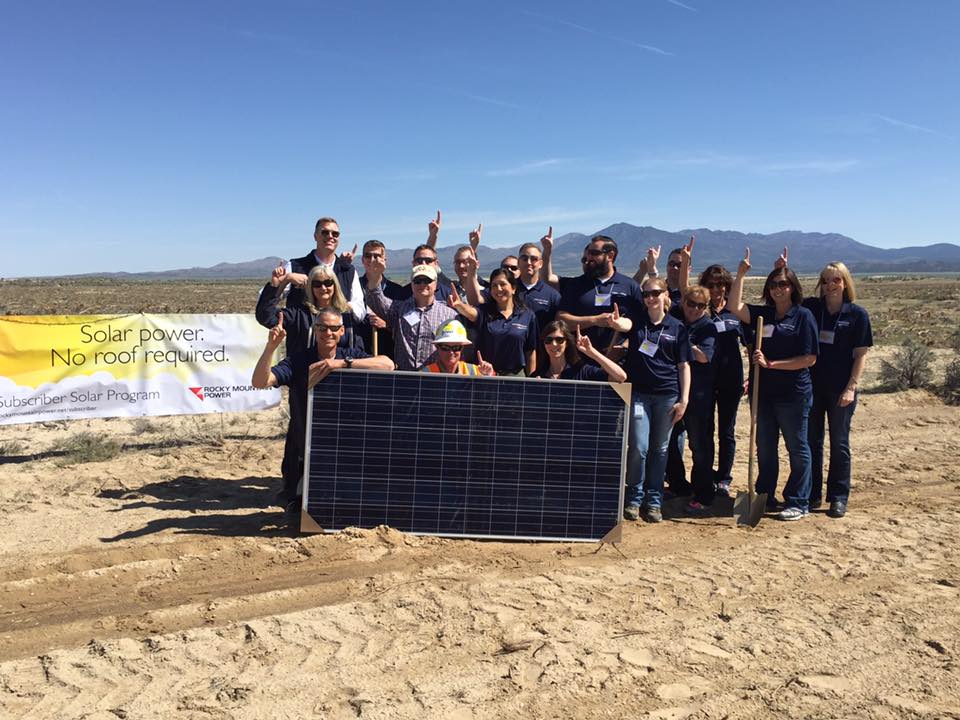The U.S. Environmental Protection Agency (EPA) launched the $27 billion Greenhouse Gas Reduction Fund to mobilize financing and deliver projects that will reduce greenhouse gas emissions and other air pollutants facing American communities. One of the fund’s three programs, the $7 billion Solar For All program, was created to deploy distributed solar energy projects – including residential rooftop solar, residential-serving community and shared solar, and storage solutions – to 60 grant recipients, ranging across all 50 states, plus territories, Tribal governments, municipalities, and nonprofits. Not only would grants and financing help deploy residential solar, but services would also be provided to eliminate other barriers ranging across siting, permitting, and interconnection.

Photo Courtesy Utah Office of Energy Development
These projects are expected to result in a more widespread deployment of this reliable energy source. The EPA estimated that the Solar For All Program would expand residential solar capacity for low-income homes by 4 GW, a one-third increase over the next five years. The impact of this available energy would be particularly felt during grid shortages.
In addition, these solar projects are estimated to eliminate more than 30 million metric tons of carbon emissions, the same amount generated by more than 7 million cars. The health of the people living in these communities would benefit from fewer pollutants and cleaner air, and the country itself will benefit from the effort to combat the climate crisis.
The projects would also ensure access to affordable energy, with cost savings on electric bills for families. According to the EPA, the average household to benefit from the program wouldsave approximately $400 per year, a savings of approximately 20 percent. Overall, these projects would deliver more than $350 million in savings per year and more than $8 billion in savings over the 25-year average lifespans of the solar assets.
Finally, the EPA estimates that the program could create 200,000 good-paying jobs over the next five years, with each grant recipient committed to local workforce development.

Photo Courtesy Intermountain Wind & Solar
Last April, the EPA announced that it had selected the Utah Governor’s Office of Energy Development to receive $62.45 million for the Solar for All for Utah (S4AU) program. KC Becker, EPA Regional Administrator, noted in the press release that “Although solar technology has become more affordable for residential use, many communities still face cost barriers to access. One of our goals with the Greenhouse Gas Reduction fund is to make clean energy more accessible, especially for communities that are both overburdened by climate change impacts and disproportionately excluded from green technology resources. The Solar for All program will make access to cleaner energy more equitable for Utah communities.”
Separately, the EPA announced that it also selected a nonprofit called GRID Alternatives to receive an additional $62.45 million for its Western Indigenous Network Solar For All (WIN-SFA) program, with its focus on several Western states, including Utah, Arizona, Colorado, Nevada, and New Mexico. GRID has been operating a National Tribal Program since 2010 and a Tribal Solar Accelerator Fund since 2018, helping bring renewable energy to Tribes around the country. In total, the nonprofit has trained more than 50,000 people, provided solar panels for more than 22,000 households, and helped families achieve lifetime energy savings of over $748 million.
Moreover, Senator John Curtis has long been a supporter of renewable energy. When he was a Representative, he founded the Conservative Climate Caucus and introduced the Providing Reliable, Objective, Verifiable Emissions Intensity Act, or PROVE IT Act. That bill directed the United States Department of Energy to report on the average emissions intensity of products made in the U.S. versus in other large economies. As he told the Sierra Club, “We want to work together as Republicans and Democrats, because at the end of the day, we all care about leaving the earth better than we found it. That’s how I talk about it—who doesn’t want to leave the earth better than we found it?”

Photo Courtesy Senator John Curtis
By January, the Utah Office of Energy Development had completed its workplan outline, received its approval from the EPA, and began seeking applications for members for three Advisory Councils that would represent residents, community-based organizations, and industry and workforce development experts. The year 2025 was meant to be a planning period for program activities and some initial deployment of financing, with most delivered in years two through five. Salt Lake City was meant to lead a pilot program to evaluate and install residential solar systems in the most overpopulated area of the state before its efforts were expanded to the rest of Utah. However, on Monday, January 27, the White House Office of Management and Budget (OMB) issued a memo telling federal agencies to “temporarily pause all activities related to obligation or disbursement of all Federal financial assistance.
The following day, the EPA sent letters to the Solar For All program’s recipients stating that it was working with the White House Office of Management and Budget to implement the president’s executive order on “Unleashing American Energy.” Section 7 of that order directs agencies to pause fund disbursement from 2021’s Infrastructure Investment and Jobs Act and 2022’s Inflation Reduction Act. A memorandum clarified that this directive referred specifically to funding for awards and contracts for clean energy and climate-related projects.
Solar For All program recipients contacted by E&E News reported that they no longer had access to the EPA’s grant management portal and lacked contact information to ask questions about the freeze. This makes uncertain Utah’s plans to use the funding to support rooftop solar through the SA4U program. The funding would have supported residential solar projects for single-family and multi-family residences, as well as 5-megawatt community solar projects for the shared benefit of eligible Utahns living nearby. The initial emphasis was on getting affordable, reliable energy sources to Utahns at risk of unplanned power outages or of having no electricity at all, as well as those relying on life-essential powered medical devices.
As Greg Todd, Director of the Utah Office of Energy Deployment, expressed in a 2024 press release, “We’ll be leveraging these funds to supply grants and low-cost financing for those who would normally find the cost of installing solar power prohibitive. In turn, funded projects will improve grid resiliency, lower emissions across the state, and lower monthly utility bills for program participants. Our office sees this as a win for our utilities, our air, and, most importantly, our consumers.”

Photo Courtesy Utah Office of Energy Development
The plans would have also seen the Utah Office of Energy Development fostering community engagement, creating workforce development opportunities, and forming innovative partnerships with project installers, as well as with residents and local municipalities. A number of partners were set to be involved in the program, including the Utah Department of Environmental Quality, Utah Clean Energy, the University of Utah, Salt Lake County, and Salt Lake City’s Department of Sustainability.
In fact, the Office of the Vice President for Research’s Energy Futures Research Engine at the University of Utah was a significant contributor to the state’s Solar For All proposal. Marian Rice, associate director of the Energy Futures Research Engine, who also serves as a Utah Solar For All Coalition member and the chair of the coalition’s community benefits committee, had expressed in a blog post that “We are excited to collaborate with Solar for All Coalition, state and local government, NPOs and community groups on projects that benefit Utah’s people, economy and ecosystem.” Erin Rothwell, vice president of research, added, “As the flagship institution for the state, it is important we support and collaborate on important initiatives that translate into improving economic stability and energy security.”

Photo Courtesy University of Utah Research
The funding freeze also puts at risk the Western Indigenous Network Solar For All (WIN-SFA) program, which would provide grants and other incentives to help bring single-family and multi-family solar projects, residential-serving community solar projects, and other affordable and advanced energy solutions to Native Americans. Associated upgrades would have enabled more solar systems to be installed than before. The estimated 4,700 impacted households across the country would have thereby benefited from lower energy costs, more job opportunities, local economic growth, and empowerment via energy sovereignty.
This financial support would have been coupled with community engagement, participatory government, and partnerships with Tribal leaders, native-led community organizations, and Tribal colleges and universities that are all centered on mutual respect. Tribal members would have also benefitted from employment training and workforce development opportunities, as well as business opportunities for enterprises owned by Tribes or their members. Notably, half of all the installation and development positions were to be filled by Tribal members. Overall, the result woukd have improved climate resilience for these communities.
Additionally, the program included technical assistance provided by partner organizations that have equitably deployed clean energy to Tribal residences in the past. GRID’s coalition partners, slated to get these solar projects up and running, included The Alliance for Tribal Clean Energy, Native CDFI Network, and Native Renewables. Pete Upton, CEO of Native CDFI Network, congratulated GRID Alternatives in the press release: “This prestigious recognition represents a significant step towards achieving clean energy equity within Native communities nationwide.” Cheri Smith, a Mi’kmaq tribal descendant, as well as President & CEO of the Alliance for Tribal Clean Energy, added, “This initiative serves as a vital step towards alleviating poverty, combating climate change, and fostering the creation of sustainable, well-paying green jobs for thousands of tribal members.” Suzanne Singer, Co-Founder and Executive Director of Native Renewables and a member of the Navajo Nation, noted, “We believe that everyone deserves access to affordable, and reliable energy solutions. Through collaborative efforts like the National Tribal Program, we can support Indigenous communities in their transition to a renewable energy future.”
Finally, GRID Alternatives would have placed an emphasis on bringing solar energy to affordable housing via its Solar Access for Nationwide Affordable Housing (SANAH) coalition. Its partners have experience deploying solar on affordable single-family and multi-family residences and would have brought that expertise to address the challenges facing this housing sector. These coalition members include the Enterprise Community Partners and Loan Fund, Habitat for Humanity, the Housing Partnership Network, the Local Initiatives Support Corporation, the National Equity Fund, National Housing Trust, NeighborWorks, Rewiring America, and the World Resources Institute.

Photo Courtesy Tribal Solar Accelerator Fund
Community leaders in Utah believe that these solar funds would go a long way to delivering economic and environmental benefits to the Utahns. Val Peterson, a Utah House Representative as well as Vice President of Administration and Strategic Relations at Utah Valley University, explained to KSL-TV that the state’s 550-acre Elektron Solar Project “is a testament of our community’s commitment to clean renewable energy and will power the city’s operations, from buses to streetlights.” If funding returns for Solar For All, other projects will have the chance to get off the ground in Utah.





